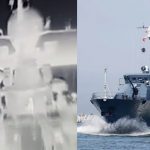
When the Target Moves: What the Lake Onega Strike Tells Us

Yesterday brought a story full of mysteries. It concerns a hostile missile boat struck on Lake Onega. Reports from Ukrainian SOF say the vessel took a hit near the engine room. What makes the case even stranger is that every source described the incident as happening while the ship was on the move — during its transfer from the Baltic Sea to the Caspian. In other words, the boat was moving along a long, pre-planned route at the time of the strike. The Lake Onega Strike has therefore raised more questions than answers. How could a moving target, deep inside Russian territory, be hit with such precision?
And as we know, Ukrainian long-range drones have so far been used only against large, stationary targets. As far as anyone is aware, they have never been deployed against moving ones. In this case, however, the vessel wasn’t just moving — it was following a specific and distant route.
A brief explanation of the route
Here’s how that route works: through a chain of canals and locks, relatively small ships can leave the Baltic, sail along the Neva River and across Lake Ladoga, then reach the Volga. From there, they can descend either to the Caspian Sea or, through the Azov, into the Black Sea. That’s exactly the corridor this boat was taking.
One could assume the ship was stationary at the time of impact. But if it had been docked — either at a permanent or temporary base — its coordinates and duration of stay could have been tracked. During a transition phase, however, especially early on the route, that would be almost impossible.
Given the Ukrainian Armed Forces’ claims about a drone strike, the drone would have needed six to seven hours to reach the target, assuming a standard strike protocol for a fixed target. That runtime requires confidence that the target would not move during those hours. Under these conditions, that confidence looks almost impossible.
There are only two plausible explanations left
First: the drone might have had autonomous target recognition enabled — the ability to find and lock onto a designated vessel once entering the operational zone.
Second: our forces might have had reliable information that the ship would remain stationary at known coordinates. Put simply, the ship must have made itself a sitting target.
Both scenarios are very bad news for the orcs. If we’ve reached the point where drones can fly deep into enemy territory and switch to onboard signature-based search, that’s a game-changing capability. The implications of the Lake Onega Strike speak for themselves. And if it was the second case — a guaranteed stop in open water, without air cover — then the level of reconnaissance behind this operation is staggering. It’s something that deserves a separate chapter in future military textbooks.
Related posts:


Ukraine hits Taganrog aircraft repair plant
Independent sources report that Ukraine hits Taganrog aircraft repair plant in Rostov Oblast — specifically, the Beriev facility. According to preliminary data, this wasn’t just a fire but [...]
Drones strike Shatura GRES in Moscow Region
Today, numerous friendly birds visited Shatura GRES in the Moscow region. Local Spielbergs don’t just film videos about their GRES but also comment on what’s happening. Obviously, they [...]